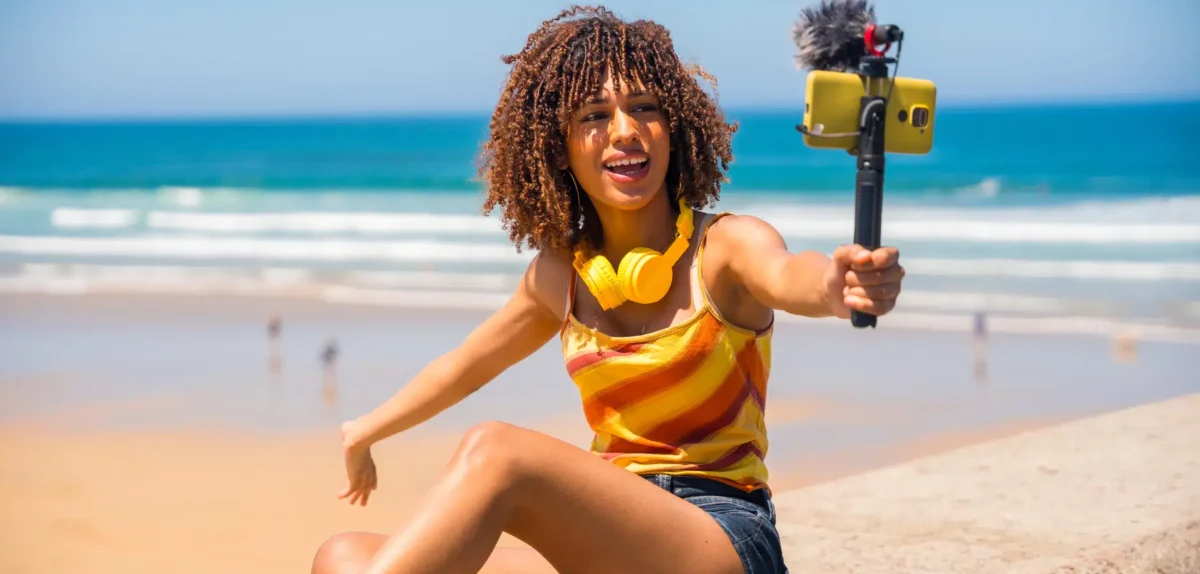Though 70 percent of marketers expected to use influencer marketing in 2025, only 18 percent feel confident in their attribution data. That makes it nearly impossible to show the true value of influencer partnerships. The Stanley Quencher tumbler is one of the exceptions.
The century-old drinkware brand went from $70 million to $750 million in revenue in just four years—not by reinventing their product, but by reinventing their approach to influencer marketing. Instead of paying creators for awareness-focused posts, Stanley built partnerships that tied creator content directly to conversions through TikTok Shop integrations and trackable affiliate links.
The result? A cultural phenomenon backed by measurable ROI. For most brands, however, viral attention doesn’t translate into reliable growth. The gap between engagement and revenue persists because influencer programs remain stuck in top-of-funnel tactics—prioritizing reach over results and views over verified purchases.
This guide shows how leading brands are closing that gap: the five strategies that convert social engagement into sales, the compensation models that align creator incentives with business outcomes, and the attribution frameworks that finally prove influencer ROI to CFOs
How does influencer marketing drive social commerce?
Traditionally, brands have partnered with creators to support top-of-funnel campaigns with brand awareness content, such as sponsored posts.
However, influencer-driven social commerce uses content creators to establish credibility at the bottom of the funnel and increase conversions. Influencers use platform-native features meant to create a seamless shopping experience, such as in-app storefronts, shoppable links, and live streams.
Defining influencer-led social commerce
Social commerce integrates e-commerce functionality directly into social media platforms, allowing consumers to move from discovery to purchase without ever leaving the app.
Influencer-led social commerce uses a combination of authentic creator content and native tools to convert social engagement into direct, measurable revenue.
As consumers increasingly turn to trustworthy recommendations over traditional ads, this play matters more than ever. Strategically placing creator-driven content at the critical moment of purchase consideration creates a seamless shopping experience, removing friction and collapsing the sales funnel.
This direct path from discovery to in-app purchase converts social engagement into measurable revenue, finally providing a clear, defensible answer to the long-standing question of influencer marketing ROI.
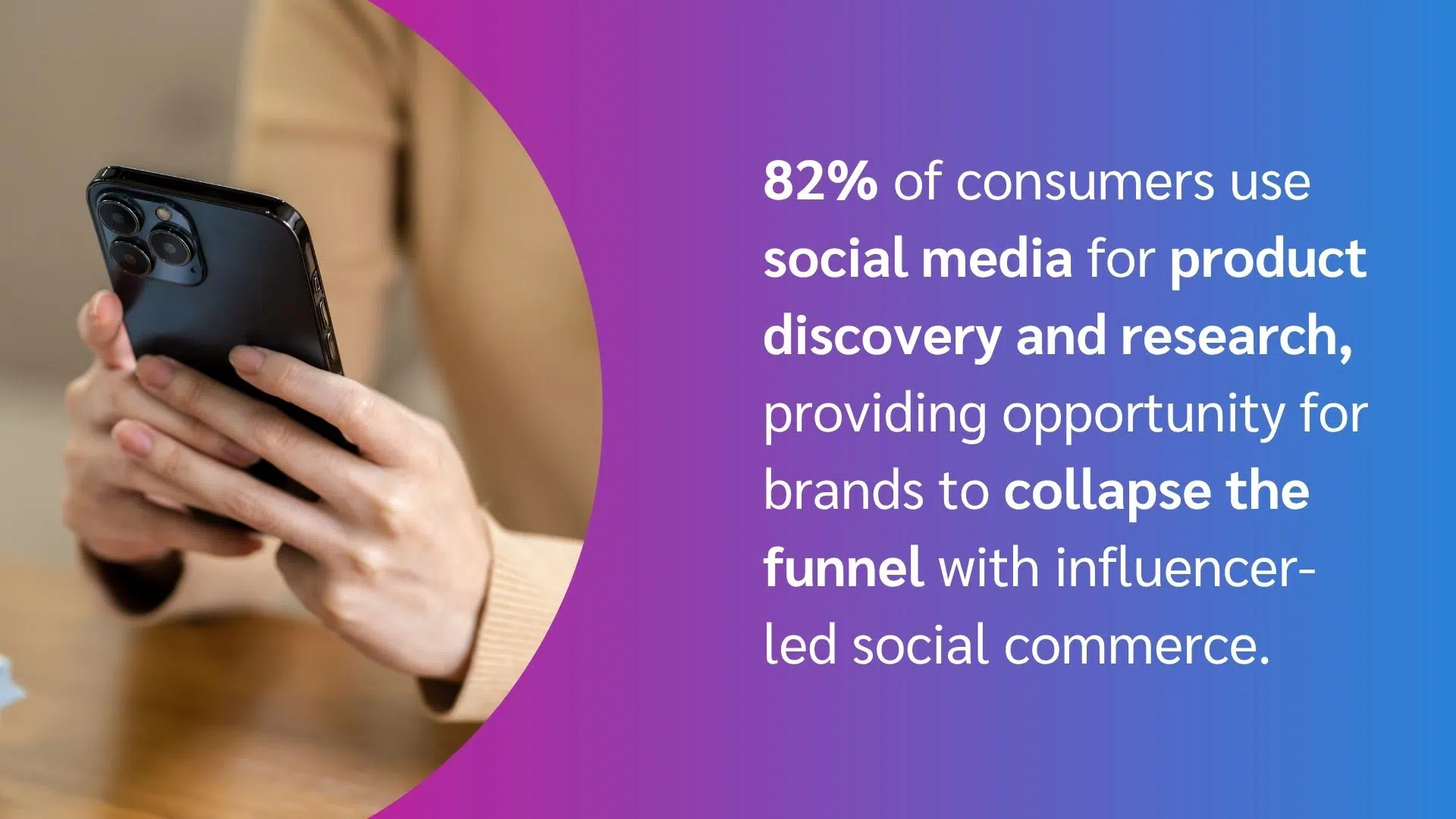
Source: Hostinger
Why influencer-led social commerce matters now
The convergence of creator partnerships and social commerce is accelerating in response to three major market shifts that are reshaping how brands connect with buyers:
Platforms creating a “commerce-or-lose-reach” ultimatum
Social platforms doubled down on native commerce in 2025, with TikTok Shop experiencing 120 percent year-over-year (YoY) U.S. sales growth. At the same time, TikTok shifted from free organic reach to a pay-to-play model, with brands reporting steep drops in unpaid views by late 2024.
Meanwhile, Instagram launched its Creator Marketplace in 2025—a native influencer management platform where brands can find creators, exchange campaign ideas, and discuss compensation directly within the platform.
These moves signal that platforms are prioritizing in-app transactions and creator-driven commerce over external traffic.
What this means for marketers
Algorithms reward brands that keep shoppers in-platform through native storefronts, shoppable content, and creator partnerships. The window to establish presence is narrowing—early adopters gain algorithmic advantage before competition intensifies.
Economic pressure elevating ROI scrutiny
Marketing budgets flatlined at 7.7 percent of company revenue in 2025, unchanged from 2024. As a result, 59 percent of CMOs report insufficient budget to execute their strategy, with 39 percent of CMOs cutting agency budgets and labor costs to stay within constraints.
In this environment, traditional awareness-focused influencer campaigns can’t justify spend. With 44.6 percent of budget cuts disproportionately impacting marketing, CMOs must tie every dollar to measurable business outcomes.
Finance teams demand attribution clarity—something social commerce provides through trackable links, in-platform transactions, and performance-based compensation models.
Consumer trust in brand content continuing to decline
By 2025, Millennials account for 33 percent of global social commerce spending and Gen Z for 29 percent—tech-savvy generations who overwhelmingly discover products through creator content rather than branded channels.
Recent research shows 83 percent of TikTok Shop shoppers have discovered a new product on the platform, and 70 percent have discovered a new brand. The discovery-to-purchase journey now happens in creator-led environments, not brand-controlled ones.
Top 5 influencer marketing strategies to drive purchases on social commerce channels
Influencer marketing gives brands direct access to creator-led communities where purchase decisions happen. On platforms like TikTok and YouTube, creators can launch in-app storefronts, host live shopping events, or amplify sponsored posts directly in the feed.
When brands align with the right creators, they:
- Maximize their reach
- Increase trust
- Create a community of engaged buyers
Here are five proven influencer-driven social commerce tactics brands across industries are using to turn these highly engaged audiences into strategic revenue.
1. Native storefronts and in-app checkout
Native storefronts shine when you want to compress the buyer’s journey into a single scroll. They work best for impulse-friendly SKUs, seasonal drops, and bundles where a quick demo plus an in-app offer can tip a buyer into purchase.
Buyers are increasingly adopting this method of social commerce, with 61 percent of people who discover products online purchasing the item from an ecommerce marketplace.
You can use creators to surface products via:
- A branded storefront or curated “collection”
- Product pins or tags within videos that show the item in action
- Limited-time promos highlighted on product tiles
Case highlight: Danielle Athena x Wavytalk
Danielle Athena, a beauty influencer with over 600k followers, uses her TikTok Storefront to feature styling tools like Wavytalk. Her tutorials direct viewers to buy instantly in-app, generating more than $5.6 million in combined revenue for the brands.
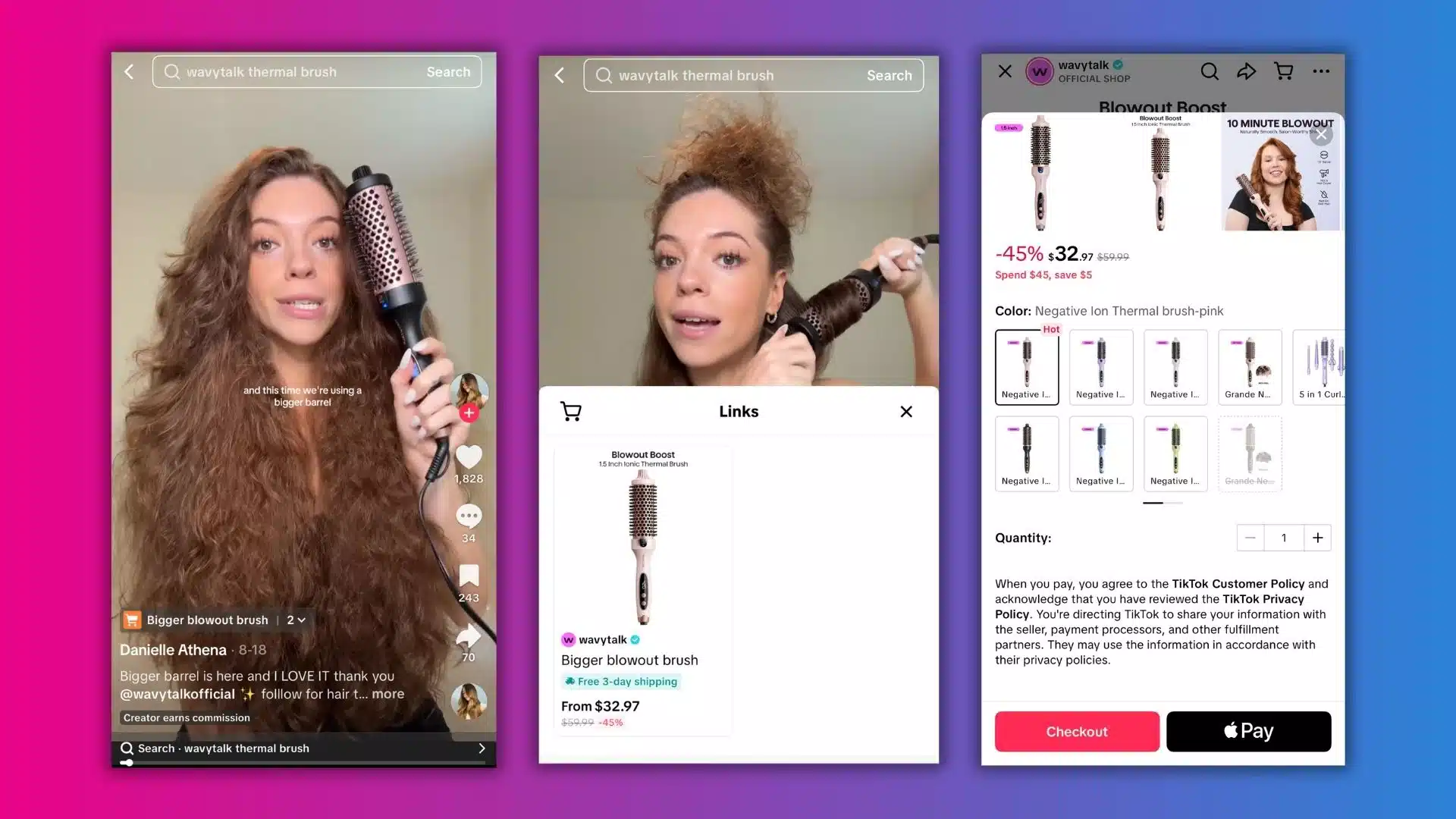
Athena’s Wavytalk tutorial leads viewers directly to TikTok Shop, where they can purchase the item directly from the app.
2. Shoppable links to product pages
Shoppable links work best when creators embed them in content designed for high-intent buyers—YouTube tutorials, Instagram carousel posts breaking down product features, or LinkedIn articles comparing solutions.
Creators can share links in different locations, such as:
- An Instagram bio or Story link sticker
- The description box or pinned comment of a YouTube video
- A clickable link within a Facebook post or LinkedIn article
Danielle Woods x Caraway
Food blogger Danielle Woods (@dinnerformyfam) integrates Caraway’s ceramic cookware into her easy, family-friendly recipe content. She promotes her affiliate link and discount code in Instagram posts and Stories, funneling her audience to purchase.
By scaling a creator-led affiliate program—seeding product, giving ambassadors promo-linked discounts for their first posts, and tracking via an affiliate manager plus post-purchase surveys—they could attribute a 13 percent lift in revenue to creator promotions. They also embedded codes in links (to auto-apply discounts) and recycled top creator content into paid ads to push conversions.
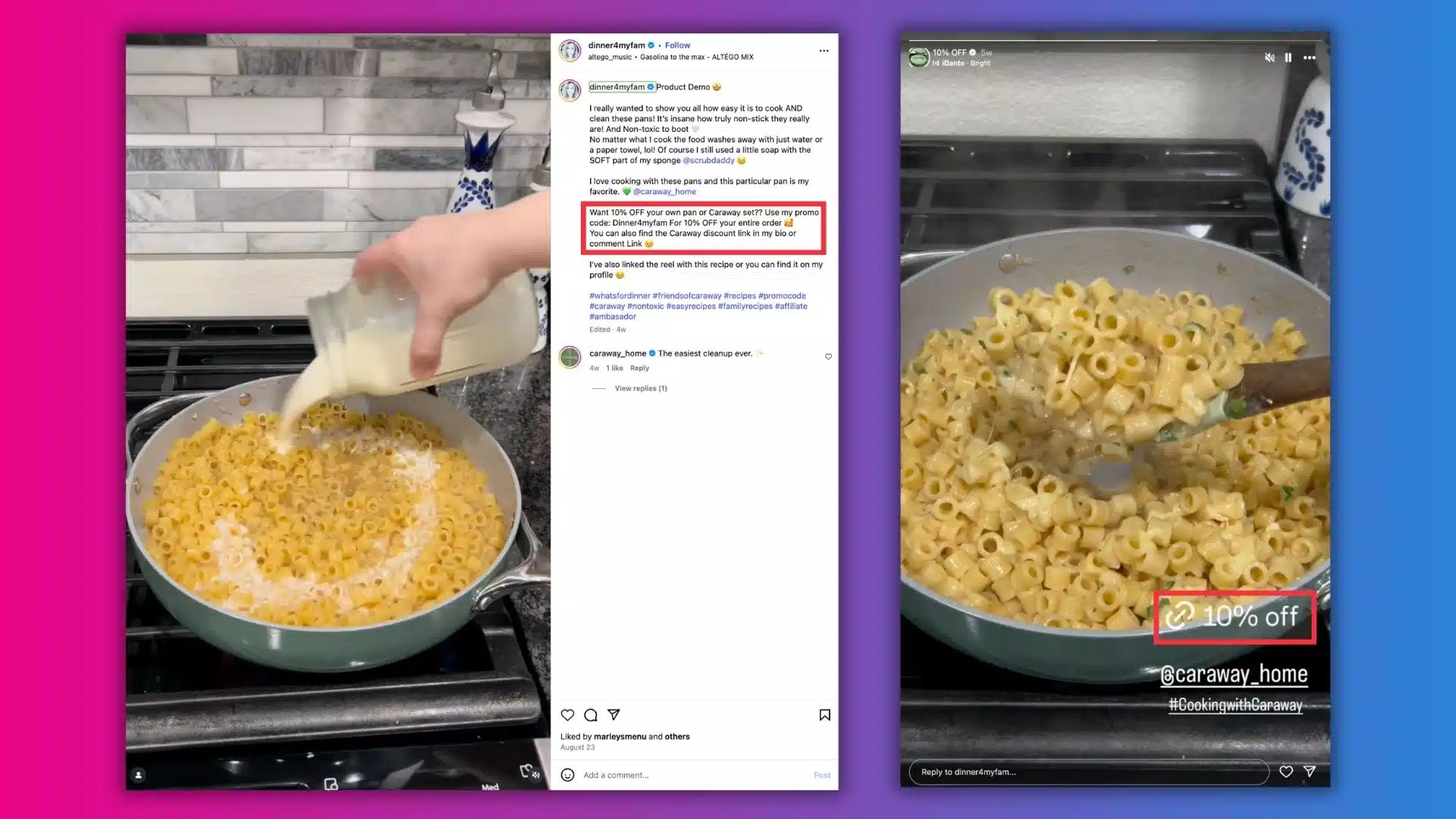
Woods regularly features Caraway in her content alongside her unique affiliate link and promo code.
3. Sponsored posts with unique links or promo codes
Think of sponsored posts as “conversion-optimized storytelling.” You control the brief and positioning while the creator delivers trusted delivery. With you pair these with a unique link or discount code, it becomes clear which promotions generate revenue.
This format works best when you need consistent messaging for launches, promotions, or category education. It also makes it easier to see which angles actually sell.
Deploy this hybrid format as:
- In-feed videos that open with a benefit-led hook and a clear CTA and link
- Carousels breaking down product features/claims, each frame reinforcing the same CTA
- LinkedIn or YouTube placements for B2B or considered purchases (link in first comment/description)
Following influencer marketing compliance best practices ensures that your ads remain within the bounds of the law. For example, the FTC Endorsement Guides require clear disclosures (#ad, #sponsored) in posts. Non-compliance risks both regulatory action and audience trust.
Violet Wadden x Olipop
Olipop, a prebiotic soda brand, partnered with agency GravityFed to activate a creator community that boosted their profile on social media. By offering $36 product samples and performance-based commission to creators like Violet Wadden, they achieved an average of 982 percent return on ad spend (ROAS) YoY and drove 12 percent of sales that year.
This approach created a clear path from discovery to action—all while gaining insight into which posts turned likes into purchases.
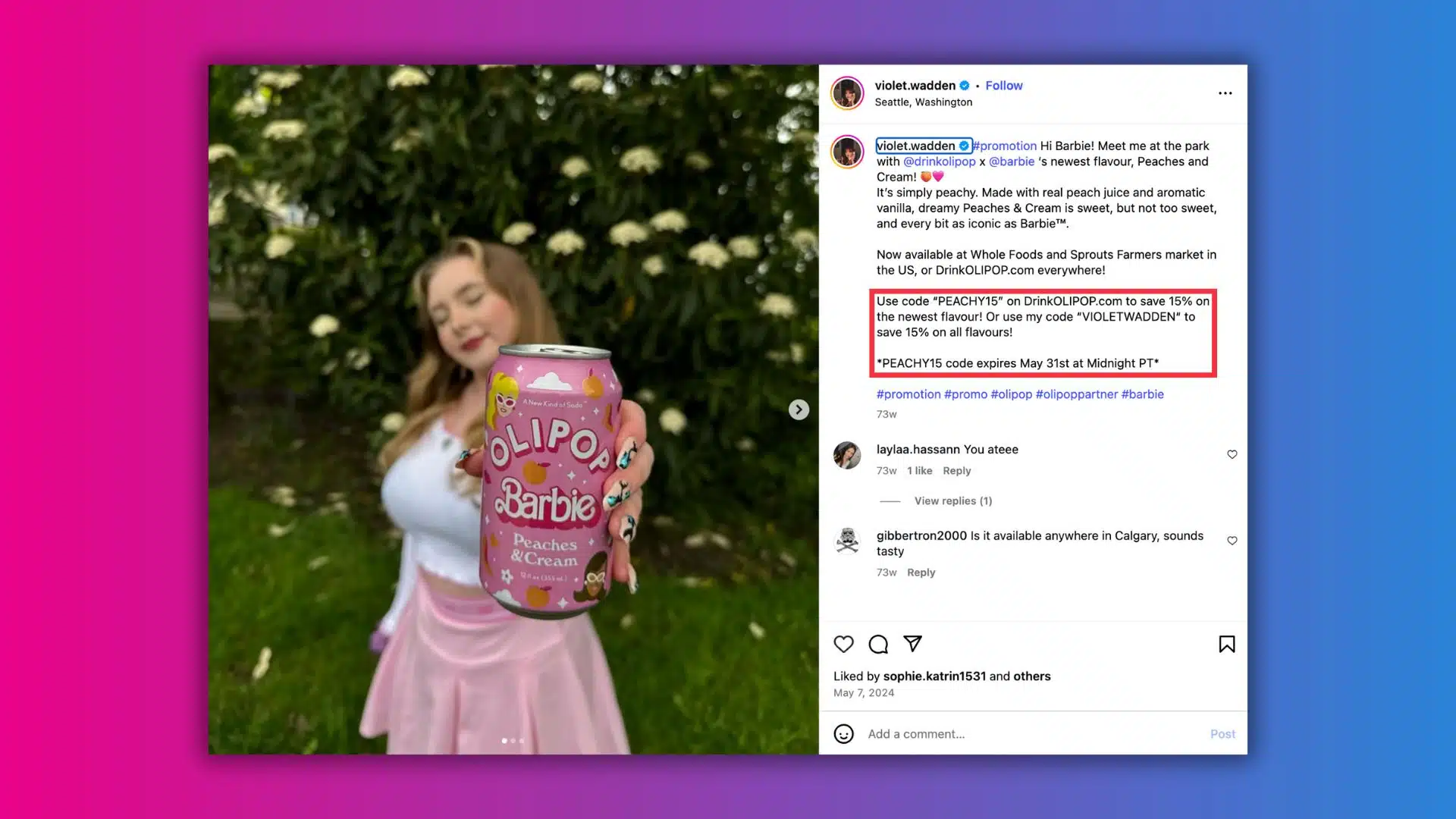
Wadden’s visually engaging content is eye-catching enough to stop the scroll, while also providing a conversion opportunity with a unique promo code.
4. Live stream shopping events
Live streams can reach a high-intent audience effectively, with TikTok’s research showing that people are 1.7 times more likely to watch a branded live stream to purchase a product.
This format converts best when buyers need a demo, social proof, or a nudge (such as limited-time offers). They’re ideal for launches, “back-in-stock” moments, and gift-guide seasons—anywhere urgency and interaction can unlock same-day revenue.
Help influencers create successful lives by providing some core guidelines for success:
- A simple run-of-show format: demo, FAQs, and an offer drop, followed by a rapid fire Q&A
- Pinning shoppable products throughout the session, with on-screen price and perk (e.g., bonus mini, free shipping)
- Seeding questions and testimonials so momentum never dips
Madalynbecky
The mother-daughter duo Madalyn/Becky host regular TikTok live streams where they highlight favorite products, such as a necklace set promoted with limited-time free shipping. Their interactive sessions engage loyal followers while attracting new viewers scrolling through live content, turning casual discovery into direct conversions.
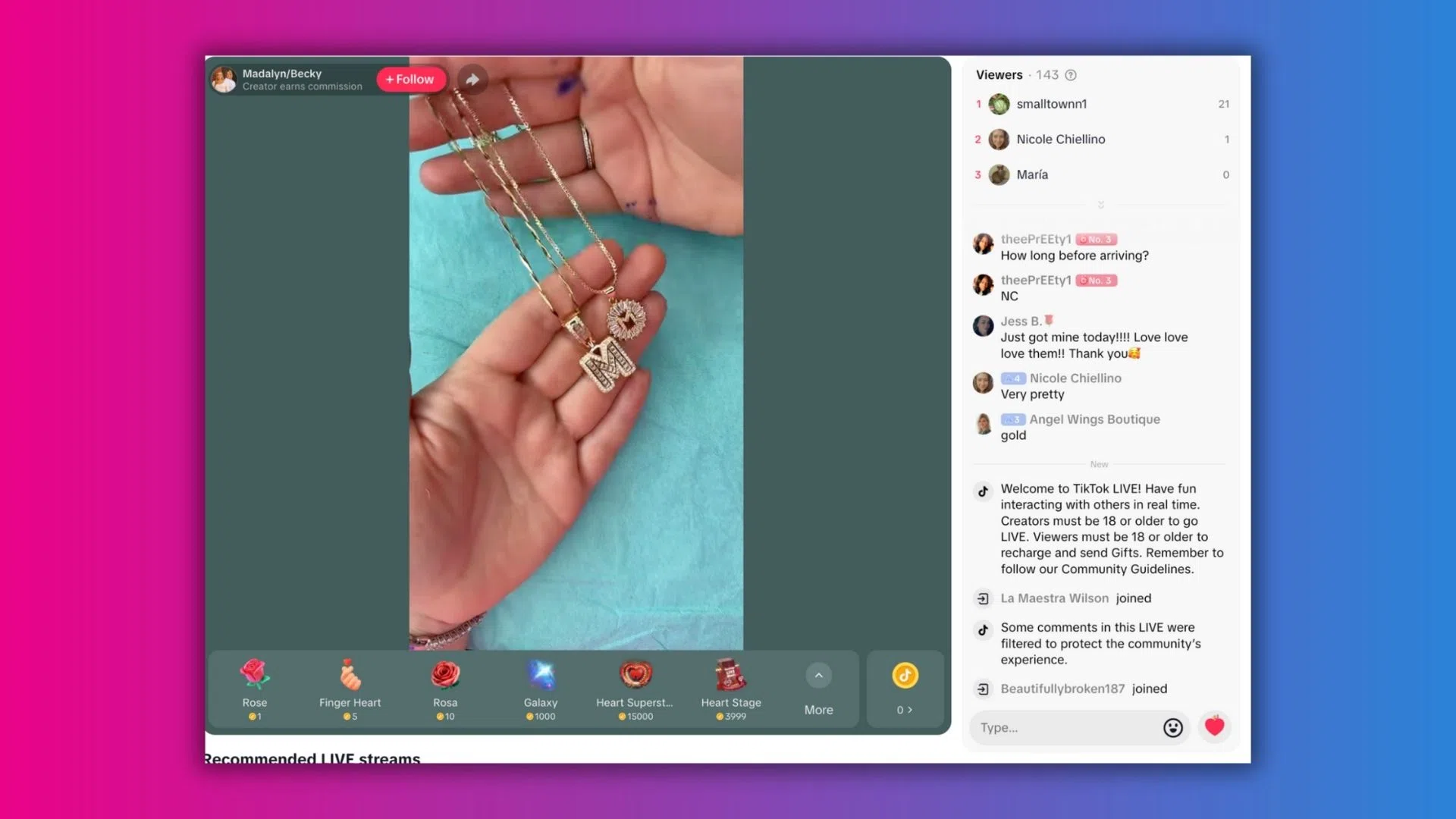
In this live stream, Madalyn and Becky shared a necklace set with their audience, mentioning limited-time free shipping to catch attention.
5. Creator whitelisting or paid amplification
Whitelisting scales what’s already working. You turn high-performing creator posts into paid ads from the creator’s handle, gaining trust in the thumb-stop while testing audiences, hooks, and offers at speed.
Use whitelisting to:
- A/B test headlines, first-3-seconds hooks, and CTAs without re-shooting content
- Build lookalikes off engaged viewers and layer retargeting for assisted conversions
- Extend winning organic posts into always-on, lower-CPA acquisition
Caitlin Mellor x GetSmarter
GetSmarter launched a campaign with impact.com promoting AI courses during the New Year’s self-improvement boom. Working with creator Caitlin Mellor and other collaborators, the team produced a series of high-impact content pieces, amplified through TikTok and Meta ads. The campaign far outperformed expectations, producing over 620,000 clicks at $0.01 cost per click.
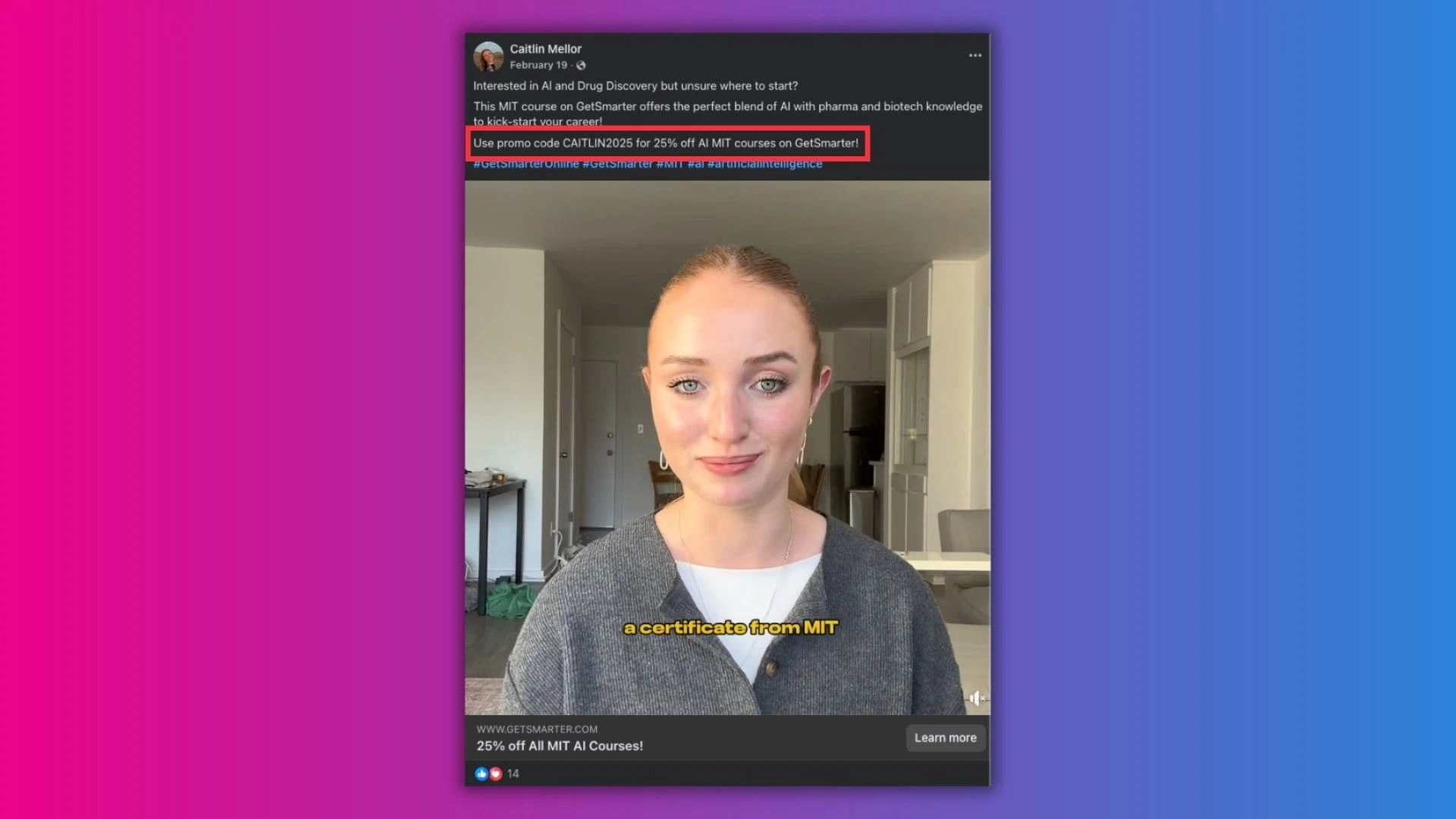
GetSmarter boosted Caitlin’s content as part of their New Year’s campaign, producing relatively low-cost ads that leverage the creator’s credibility to capture attention.
Creating compensation models that inspire influencers to convert
As brands begin implementing influencers as a bottom of funnel tactic, they need to use compensation models that motivate the right creators to drive results.
The traditional per-post fee doesn’t reflect their full impact on the buying journey. A single post might spark awareness, but conversion often happens days—or even weeks—later.
Modern compensation shifts the focus from output to outcomes. The most effective models balance guaranteed pay with incentives tied to performance, motivating creators to sell authentically while ensuring brands achieve measurable returns.
By adding a performance component to creator compensation, brands ensure both sides win when sales occur.
Hybrid compensation
Hybrid compensation models blend the stability of a flat fee with the scalability of performance-based incentives. Creators are paid for their time and effort in producing content, while also earning additional income based on the sales or conversions they drive.
Why it works: Hybrid models align incentives without leaving either side exposed. Creators feel fairly compensated for their creative work, and brands ensure their biggest payouts come from measurable sales impact. This approach is especially effective for longer campaigns, seasonal launches, or when testing new products, since it balances upfront investment with outcome-driven rewards.
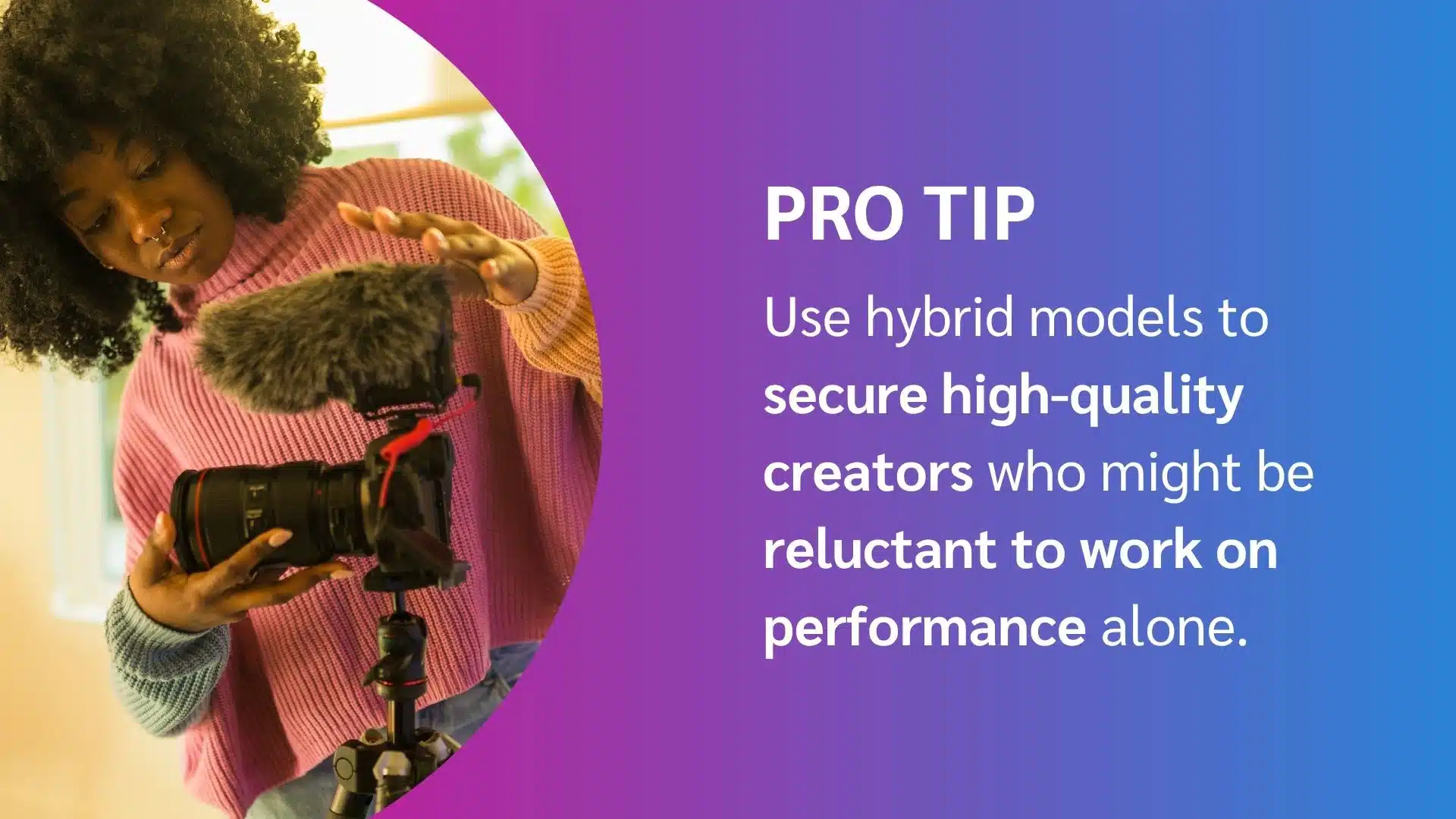
Revenue share or CPA structures
Revenue share and cost per action (CPA) structures award creators with a percentage of each sale or a fixed payout per completed purchase.
Why it works: This model connects creator pay directly to the value they bring to a brand’s revenue, eliminating the guesswork around ROI. For brands with longer sales cycles or multiple touchpoints, like B2B companies, this payout model keeps creators motivated—even if the sale happens long after interaction with their content.
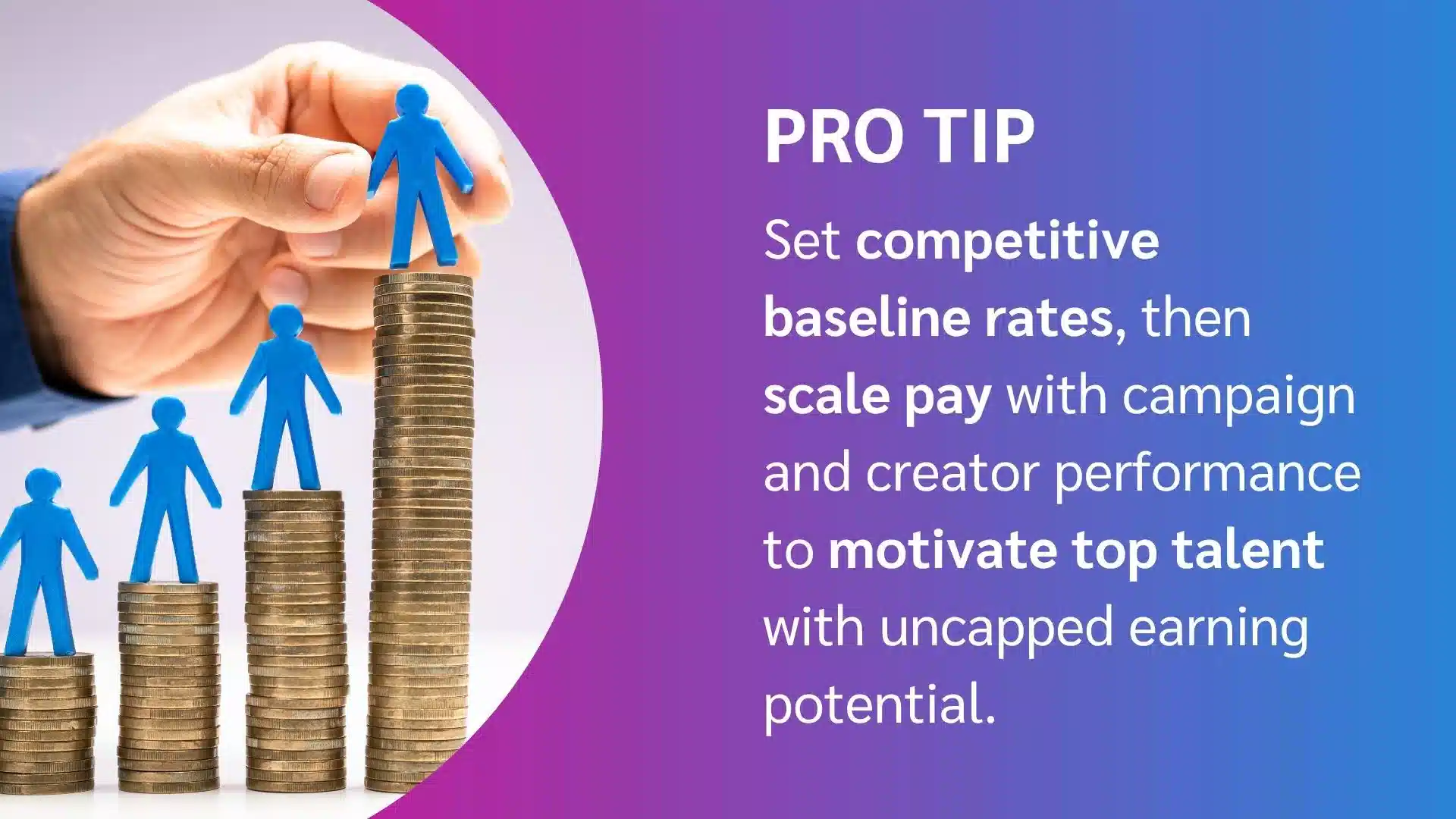
Tiered performance bonuses
Tiered performance bonuses reward creators with extra payouts once they cross set sales thresholds. For example, a creator may receive an additional monetary incentive once they generate 500, 1,000, or 2,500 conversions.
Why it works: Tying performance bonuses to compensation gamifies campaigns. Creators are motivated to push past each milestone, driving more conversions and higher-value sales. For brands, it’s cost-effective. Bonuses are only paid when results are delivered.
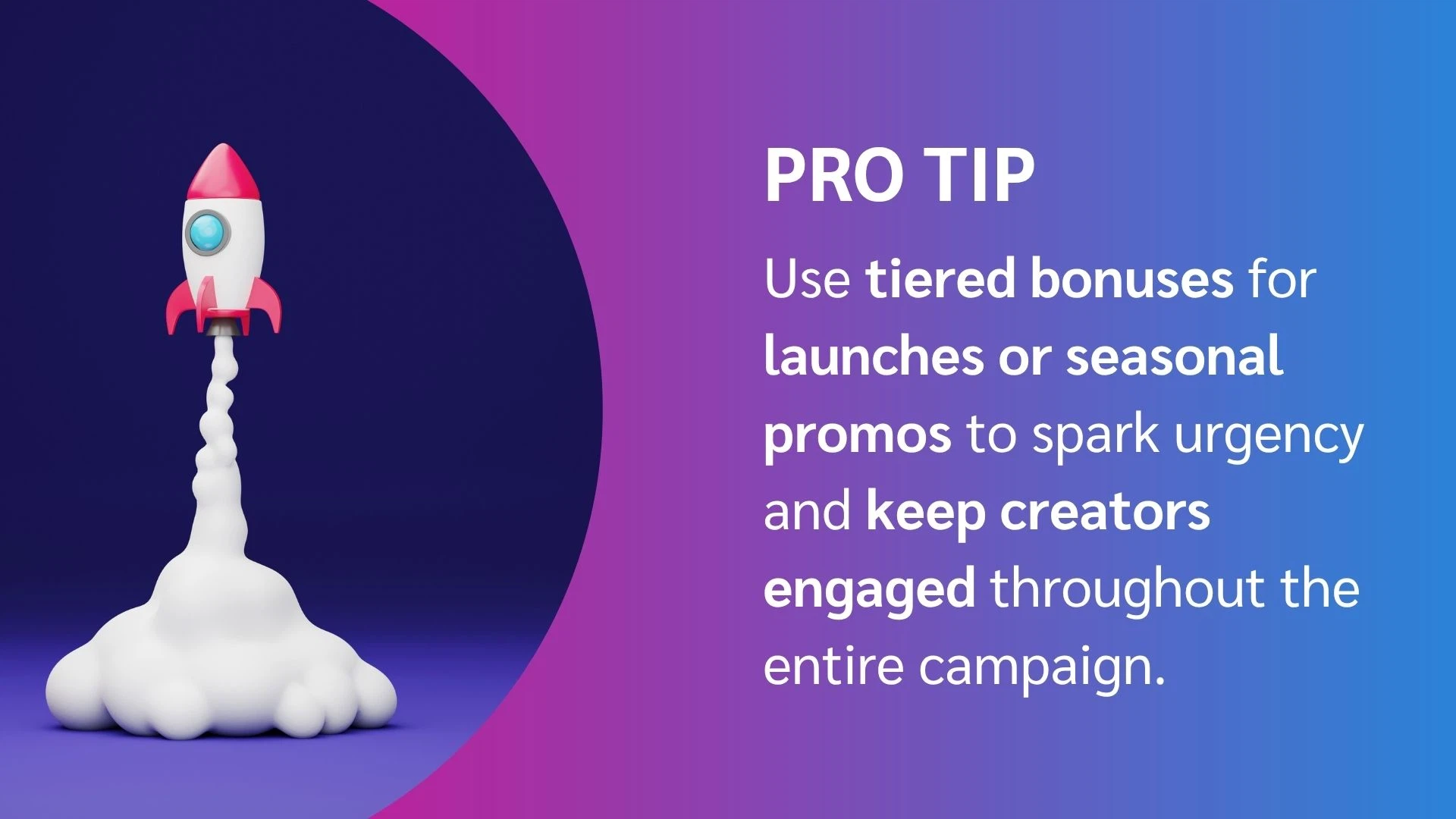
Commission by product category
On top of a flat fee for content, brands can pay increased commissions based on SKU or product category. For example, a brand might offer a 5% commission on a core product, or 15% commission on accessories with higher margins.
Why it works: Not all sales are the same. Commission incentives protect margins while nudging creators to spotlight products with a higher return. It also offers creators flexibility to tailor content to what their audience values the most.
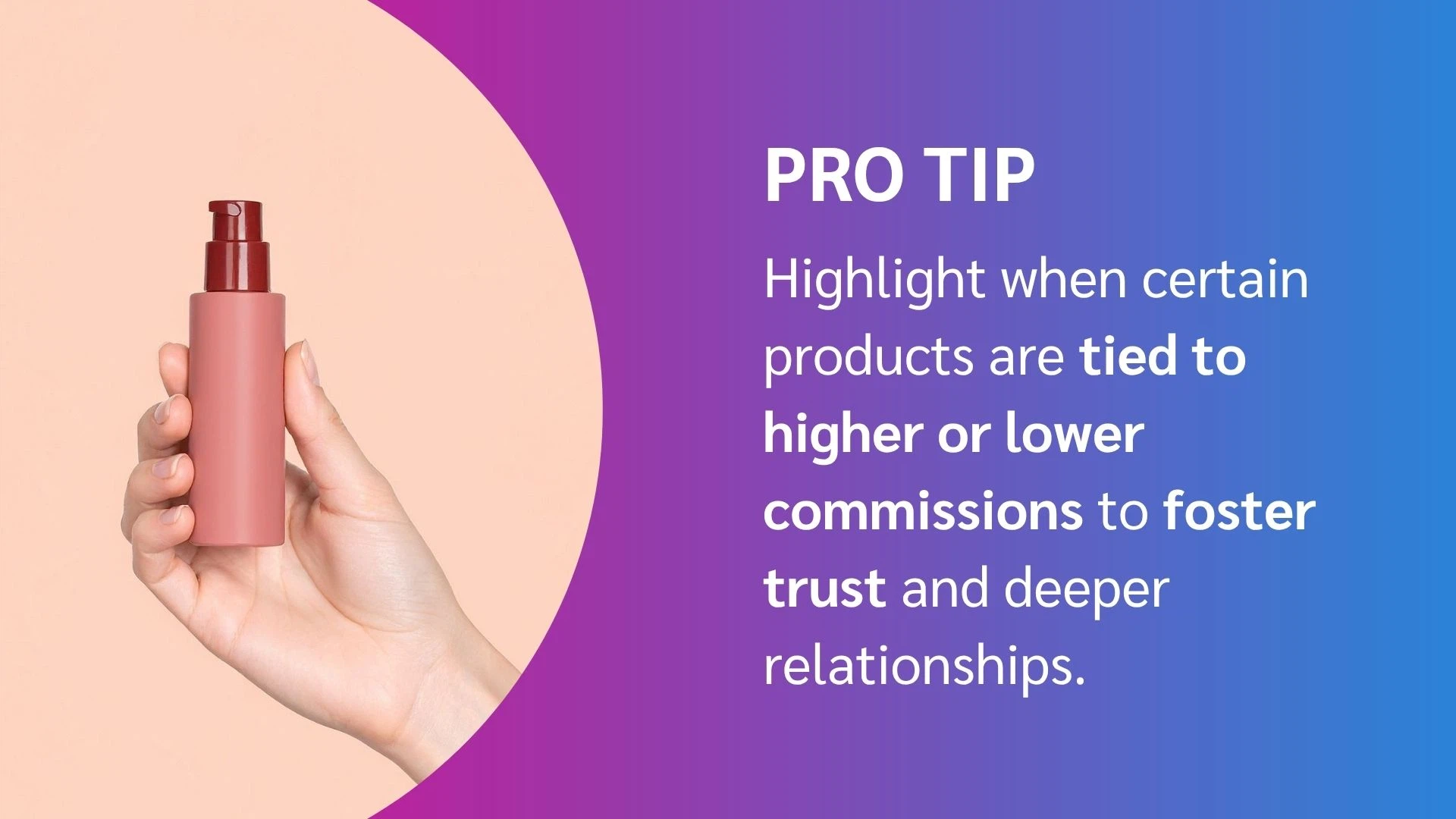
Multipliers for new customers
Multipliers go beyond standard commissions by paying influencers more for first-time buyers than repeat purchases. For example, creators may earn a 20% commission on purchases made from a new customer compared to 10% commission from loyal ones.
Why it works: Acquiring new customers can be more challenging than retaining existing ones. Multipliers give creators more incentive to expand their customer base instead of relying on their existing audience.
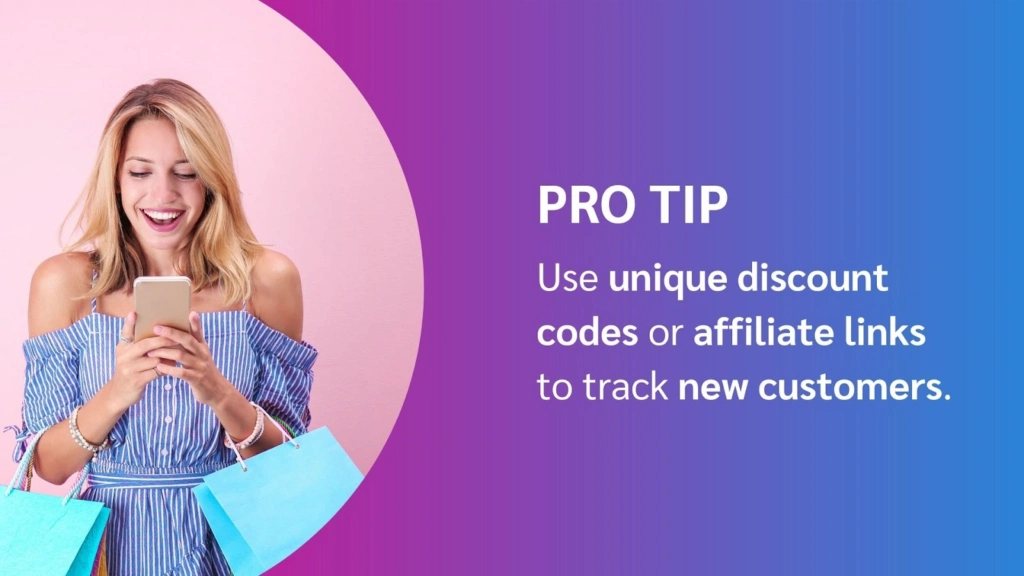
Proving the ROI of your influencer-led social commerce strategy
In 2022, Grand View Research valued the U.S. social commerce market at almost $90 billion, and projected 29 percent growth by 2030.
As more consumers turn to social media to make buying decisions, brands that lean into creator partnerships will be positioned to capture this momentum.
Still, leadership expects proof that influencer marketing delivers measurable value. The best way to demonstrate this is by tracking performance against core KPIs:
- Gross Merchandise Value (GMV). Measures the total sales revenue generated through influencer-driven campaigns.
- Average Order Value (AOV). Defines the average spend per transaction attributed to creator partnerships.
- Conversion Rate (CVR). Measures the percentage of an engaged audience that completes a purchase.
- Return on Ad Spend (ROAS): Describes the revenue generated for every dollar invested into creator-led campaigns.
Alongside these metrics, implementing clear rules and guardrails makes it easier to secure buy-in from leadership:
- Attribution rules. Define whether creators receive credit for conversions based on link clicks, discount code redemptions, or both.
- Performance models. A single-touch mode—like last-click—gives all credit to the final influencer before purchase. Multi-touch models, by contrast, distribute credit across creators who influenced earlier in the customer journey.
- Deduplication rules. Eliminate double-counting across channels for the same conversion.
- True performance. Use incrementality testing to prove the lift directly driven by your program.
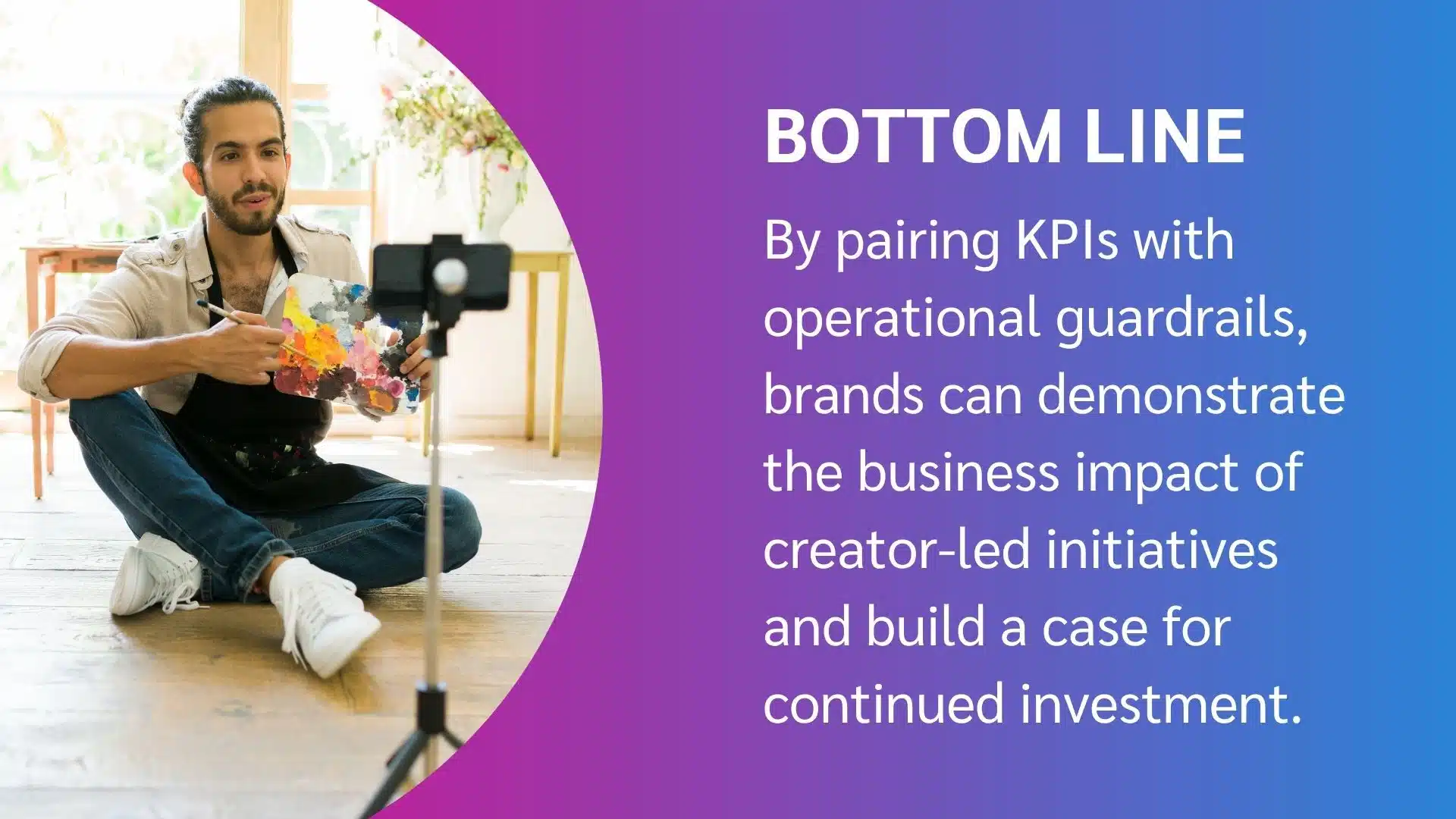
Connecting spend to revenue with AI tools and attribution platforms
Attribution has always been one of the toughest challenges in influencer-led social commerce. Customers may encounter a product through multiple creators, across several platforms, and even revisit days later before making a purchase. This often leave marketers with an incomplete picture of what’s driving results if they don’t have the right tools.
Modern attribution platforms powered by AI make social commerce and influencer marketing easier. These tools:
- Move beyond static attribution models, more accurately crediting brand ambassadors for their efforts
- Forecast ROI of potential partnerships before investing in a new partnership
- Automate partner discovery based on audience match
- Offer customizable dashboards that turn complex data into clear insights for leadership
The result is clarity. Instead of guessing which influencers are worth reinvesting in, brands can confidently connect spend to revenue, prove incremental lift, and scale with ease.
Turning creator partnerships into measurable growth
Influencer marketing has evolved beyond top-of-funnel brand awareness. When combined with social commerce, creator partnerships can become a reliable revenue engine—shortening the path from discovery to purchase.
Scaling these programs requires more than just a one-off campaign. From creator discovery to contracts, payments, and performance tracking, brands need the right technology foundation.
With impact.com’s partnership management platform, it’s possible to manage influencer-led social commerce programs with confidence and precision.
Want to learn more about maximizing creator partnerships? Explore related impact.com resources:
- Moving beyond awareness: How creators drive conversions through social commerce and affiliate programs (blog)
- How to pay content creators in 2025: 7 proven payment methods that drive results (blog)
- The marketer’s guide to increasing revenue with B2B social commerce strategies (blog)
FAQs
Influencer-led social commerce is when brands partner with creators to drive purchases directly within social platforms through storefronts, links, shoppable posts, or live streams.
While in-app checkout features like TikTok Shop or Instagram Checkout represent the most seamless shopping experience, redirected checkouts—where users are sent to a brand’s site— also qualify as social commerce. In both cases, discovery and purchase are tied together through creator content.
By leveraging authentic creator voices, brands meet buyers where they already spend time—scrolling, watching, and shopping on social media—and provide a faster path from inspiration to transaction.
Brands can leverage influencer marketing by tapping into both platform-native shopping features (like in-app checkout, product tags, or live shopping) and off-platform links that guide audiences to branded storefronts. The key is reducing friction so discovery and purchase happen in as few steps as possible.
To maximize impact, compensation models should be tied to conversions. When creators know their earnings scale with sales, they’re motivated to produce content that not only drives clicks but actually converts. Hybrid structures—flat fees plus performance bonuses—help strike that balance.
Brands can then amplify winning content with paid placements such as creator whitelisting or Spark Ads. This turns organic momentum into scalable, trackable sales growth.
Small businesses can use influencer marketing to grow their social commerce revenue by collaborating with micro- and nano-influencers to maximize authentic reach. Use shoppable links, and start with hybrid compensation models to manage costs.
Because these links are trackable, small businesses can see which creators drive conversions and reinvest in the highest performers. This data-driven approach helps stretch smaller budgets further.
Consider tracking:
- Gross Merchandise Value (GMV), which reflects total sales driven
- Average Order Value (AOV), which highlights how much customers spend per purchase
- Conversion Rate (CVR), which measures how effectively influencer-driven traffic turns into buyers
Return on Ad Spend (ROAS) also shows how much revenue is generated for every dollar invested in influencer partnerships. These metrics provide a clear picture of the financial performance of your campaigns.
Beyond these metrics, advanced tests like incrementality studies can prove whether influencer campaigns are truly driving net-new revenue rather than capturing purchases that would have happened anyway.
Marketing automation platforms are essential for accurately measuring the performance of influencer-led social commerce. These tools track multi-touch customer journeys, deduplicate conversions across channels, and attribute sales to the right creators—ensuring you’re not overpaying or double-counting results.
The most cutting-edge platforms often use AI and machine learning to forecast the potential ROI of a campaign before you invest. They can also automate partner discovery, matching your target audience with creators who align with your brand values and demographics.
Solutions like impact.com provide customizable dashboards, automated reporting, and advanced testing capabilities. With these tools, marketers can confidently tie influencer spend to revenue outcomes, giving leadership the clarity needed to scale investment in social commerce influencer marketing.


